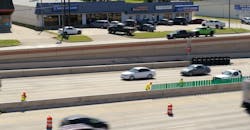The number of people dying while trying to cross high-speed freeways has skyrocketed 60% in the last 10 years, according to a 2020 report from the Insurance Institute for Highway Safety. To help save lives, the Dallas District of the Texas Department of Transportation (TxDOT) turned to an innovative version of an old familiar product.
Over the course of three years, TxDOT saw seven deaths of pedestrians attempting to cross I-30 in Dallas to reach a shopping center. Even though there was a bridge within a quarter mile of either side of where the fatalities occurred, people continued to try to cross eight lanes of interstate highway traffic. TxDOT allocated funds to build a pedestrian bridge, but the department decided to pursue a stopgap measure before bridge construction even began.
“We first considered a chain link fence, but a fence becomes a maintenance issue over time and catches debris,” said Martin Gonzalez, an engineer for TxDOT who is now director of maintenance for the Beaumont District. Then he remembered a glare screen product he viewed at the American Traffic Safety Services Association (ATSSA) Traffic Expo.
Selecting a Solution
The Plasticade glare screen system is a vertical blade and rail system that attaches to the median barrier wall to protect construction workers and drivers on the other side of the highway from the headlight glares of opposing traffic, hence the name. For decades, it has also been used to curtail gawking in work zones. When Gonzalez decided to go with the glare screen, TxDOT became the first known entity to use a glare screen as a pedestrian deterrent.
Glare screen blades are typically 14.5 in. apart, according to Thomas Safford, National Safety Manager for Plasticade, a manufacturer of traffic safety products that designed the innovative glare screen for TxDOT. For this application to deter pedestrians from crossing high-traffic freeways, Plasticade spaced the blades 7.25 in. apart, which makes the glare screen look more like a solid wall. Pedestrians would have to break the blades to get across, which they do not.
TxDOT saw deaths drop from seven to one. “We’ve found glare screens as a pedestrian deterrent is a low-cost solution with a high success rate,” said Gonzalez.
Ease of Installation and Results
Not only is the Plasticade glare screen effective as a pedestrian deterrent, it is also easier to work with. Over 3 miles of glare screen can fit on one semitruck, compared to 1 mile of older versions of the product. Because it stacks, it takes up to one-fifth of the space as a traditional glare screen.
The new and improved glare screen is comprised of durable and long-lasting polymer plastic, which eliminates the possibility of fiberglass splinters or rust. Since it is made from PVC, rather than fiberglass, it does not require workers to wear protective equipment to handle it either.
Following the pilot project, TxDOT expanded with a second project that included more than 125,000 linear ft of installed product on four highways in the Dallas District. The 5 miles of glare screen installation was estimated to take 12 to 14 months to complete. Lite & Barricade of Dallas (L&B) was able to complete the bulk of installation work in under 100 working nights.
According to L&B supervisor Alex Saenz, who led the project as a subcontractor under general contractor Select Maintenance, the installation was surprisingly simple and easy to learn. Installation was completed much sooner than anticipated due to the efficient transport of the product and the ability to quickly assemble the product directly on the barrier, which has minimal parts. Once the crew created a system (one worker places bases, one worker drills holes, one worker installs bolts, and one worker pops in blades), they averaged 1500 linear ft per night.
The Dallas District of TxDOT has greatly expanded the use of glare screens to additional area highways since the initial project several years ago on a short section of I-30.
“If TxDOT decides to remove the product in the future, the system can be easily disassembled and stored compactly,” Saenz said. “The future of the product is limitless. Municipalities, counties, toll authorities, and state agencies should all consider the product.”
---------------
Editor's Note: Scranton Gillette Communications and the SGC Infrastructure Group are not liable for the accuracy, efficacy and validity of the claims made in this piece. The views expressed in this content do not reflect the position of the Roads & Bridges' Editorial Team.
